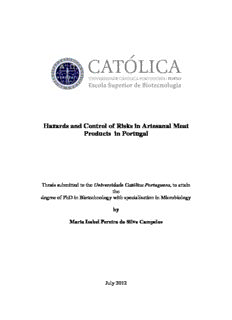
Hazards and Control of Risks in Artesanal Meat Products in Portugal PDF
Preview Hazards and Control of Risks in Artesanal Meat Products in Portugal
Hazards and Control of Risks in Artesanal Meat Products in Portugal Thesis submitted to the Universidade Católica Portuguesa, to attain the degree of PhD in Biotechnology with specialisation in Microbiology by Maria Isabel Pereira da Silva Campelos July 2012 Hazards and Control of Risks in Artesanal Meat Products in Portugal Thesis submitted to the Universidade Católica Portuguesa, to attain the degree of Ph.D. in Biotechnology with specialisation in Microbiology by Maria Isabel Pereira da Silva Campelos Under the supervision of Professor Paula Teixeira Under the co-supervision of Professor Paul Gibbs Under the co-supervision of Professor Tim Hogg July 2012 ―The known is finite, the unknown infinite; intellectually we stand on an islet in the midst of an illimitable ocean of inexplicability. Our business in every generation is to reclaim a little more land.‖ Thomas Henry Huxley. 1884 ―Remember that all models are wrong; the practical question is how wrong do they have to be to not be useful‖. George Edward Pelham Box, 1987 ―The best model of a cat is another cat or, better, the cat itself‖, Norbert Wiener, 1970 To my Father General Introduction GENERAL INTRODUCTION ―Salpicão de Vinhais‖ and ―Chouriça de Vinhais‖ are traditional dry-fermented smoked meat sausages produced in the Vinhais, a small region of Trás-os-Montes. These sausages are registered as Protected Geographical Indication (PGI) and are a significant economic and cultural asset. The production of this kind of product is mainly empirical, developed and perfected through centuries. The scientific knowledge of this sausage variety is limited. Hence, the collection of sound, scientific knowledge regarding its microbiological and chemical characteristics is a necessity and a helpful tool for producers, retailers, official control agencies and consumers, providing for much needed information regarding quality and food safety. Quantitative microbiological risk assessments aim at evaluating the risks, namely the probabilities and severities of adverse health effects for consumers, resulting from the exposure to pathogenic microorganisms present in foods, and implementing appropriate management options. Governments need risk assessment in order to select risk management measures for food trade at national and international levels, avoiding risks to the population. But also, risk assessment can be useful at production, at retailer, and at consumer levels. This work aims to collect scientific data that could, partially, fill the gaps in knowledge regarding these products, analyse the data and develop a risk-based study, according to an internationally accepted framework and finally, to explore the effect of hypothetical risk management measures on the safety of consumers, regarding traditional dry fermented meat smoked sausages. i General Introduction To perform a quantitative microbiological risk assessment, relevant data was either extracted from experimental data and when this was not possible, from relevant scientific literature. To perform the exposure assessment, a probabilistic model was developed. Since the physico-chemical (intrinsic) characteristics of the final product traditional dry fermented smoked sausages, fall near the boundaries that allow, or not, growth of L. monocytogenes, a growth/no growth equation, specific for the conditions of ―Salpicão‖ and ―Chouriça de Vinhais‖ was developed to be included in the model. Though official organisations like the European Food Safety Agency, state the relevance of growth/no growth boundaries, few risk assessments incorporate this in their exposure assessment models. Traditional dry fermented smoked sausages present low to medium risk to the health of consumers. The use of more restrictive Performance Objectives during processing and/or distribution will result in a further reduction of risk. A more rigorous control of final product water activity and the use of a bacteriocinogenic bioprotective culture during production may contribute significantly to reducing the risk of listeriosis in consumers of these Traditional Dry Fermented Smoked Sausages ii
Description: